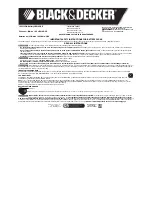
EC400 / EC450 series Power Control System
E
C
45
0
Issue 1
Page 7 of 13
12
th
June 2011
3.3 Smart Charging
On
EC468
and
EC469
PSU’s, the system incorporates a smart charge feature, which monitors both
leisure and vehicle batteries and automatically adjusts and directs the charger power (and solar power
if a solar panel is installed) to maintain the leisure and vehicle batteries at an optimal level.
3.4 Leisure Battery
A) Type / Selection
For optimum performance and safety it is essential that only a proprietary brand LEISURE battery is
used with a typical capacity of 75 to 120 Ah (Ampere / hours). A normal car battery is NOT suitable.
This battery should always be connected when the system is in use.
The PSU is configured to work with standard lead acid leisure batteries, and in most cases is also
compatible with the latest range of Absorbed Glass Matt (AGM) batteries. Before fitting non-standard
batteries please check that the charging profile described in 3.2 is suitable for the type of battery by
referring to the battery documentation or battery manufacturer.
Some vehicle installations can cater for two leisure batteries connected in parallel. In these cases it is
recommended that two identical batteries are used.
The battery feed is fitted with an inline fuse between the battery and the electrical harness, and is
usually located immediately outside the battery compartment or within 500mm of the battery. The
maximum rating of this fuse is 20A per battery. If a single battery is fitted to a motorhome, this fuse
may be increased to 40A, however if two batteries are fitted each battery should be fused at a
maximum of 20A.
B) Installation & Removal
Always disconnect the 230v mains supply and turn the PSU green charger switch to the off position
(button out) before removing or installing the battery.
When connecting the battery, ensure that the correct polarity is observed (black is negative [-] and red
is positive [+]) and that the terminals are securely fastened. Crocodile clips must not be used.
WARNING
Explosive gases may be present at the battery. Take care to prevent flames and sparks in the vicinity
of the battery and do not smoke.
C) Operation / Servicing
Under normal circumstances it should not be necessary to remove the battery other than for routine
inspection of the terminals and “topping up” of the battery fluid where applicable. Please see
instructions supplied with the battery.
Note: Do not over discharge the battery. One of the most common causes of battery failure is when
the battery is discharged below the recommended level of approximately 10v. Discharging a battery
below this figure can cause permanent damage to one or more of the cells within the battery.
To prevent over discharge, the EC400-450 system incorporates a battery protect circuit that warns the
users and then disconnects the batteries when they fall below set values.
If the power is turned on and the leisure battery level falls below 9V a warning beep will be heard and
the leisure battery gauge 10V LED will flash. To cancel the warning, press the levels button.
If the power is turned on and the vehicle battery level falls below 10.9V a warning beep will be heard
and the vehicle battery gauge 10V LED will flash. To cancel the warning, press the levels button.
These warnings will not be repeated unless the power switch is turned off and on again. This is to
ensure the warning does not become a nuisance.































